Comprehensive Report: Australian Franking Credits and Negative Gearing
VerifiedAdded on 2022/10/02
|9
|2315
|323
Report
AI Summary
This report delves into the complexities of Australian taxation, focusing on franking credits and negative gearing. It examines the definitions of these terms, their operational mechanisms, and their impact on shareholders and property investors, respectively. The report analyzes the effects of potential policy changes, such as those proposed by the Labor party, on the Australian economy and various segments of the population, including self-funded retirees and high-income earners. It explores the implications of altering negative gearing rules and dividend imputation credits, considering perspectives from economists and political commentators. The report also discusses the advantages and disadvantages of these tax policies and suggests strategies for optimizing tax reporting. The conclusion highlights the potential benefits of the proposed changes in boosting housing construction and affordability, while also acknowledging the need for adjustments in the market. Finally, the report references various sources to support the findings and analysis.
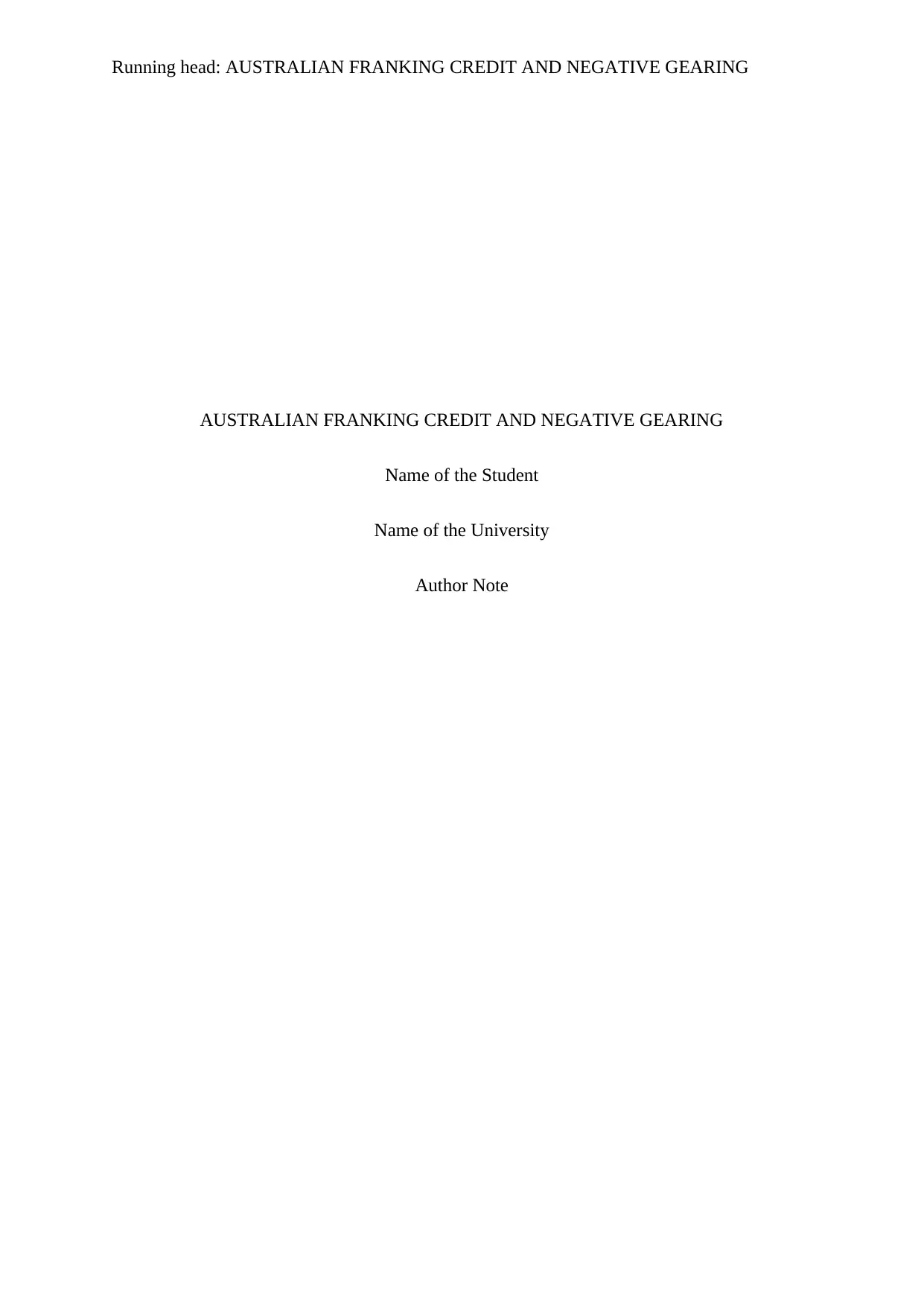
Running head: AUSTRALIAN FRANKING CREDIT AND NEGATIVE GEARING
AUSTRALIAN FRANKING CREDIT AND NEGATIVE GEARING
Name of the Student
Name of the University
Author Note
AUSTRALIAN FRANKING CREDIT AND NEGATIVE GEARING
Name of the Student
Name of the University
Author Note
Paraphrase This Document
Need a fresh take? Get an instant paraphrase of this document with our AI Paraphraser
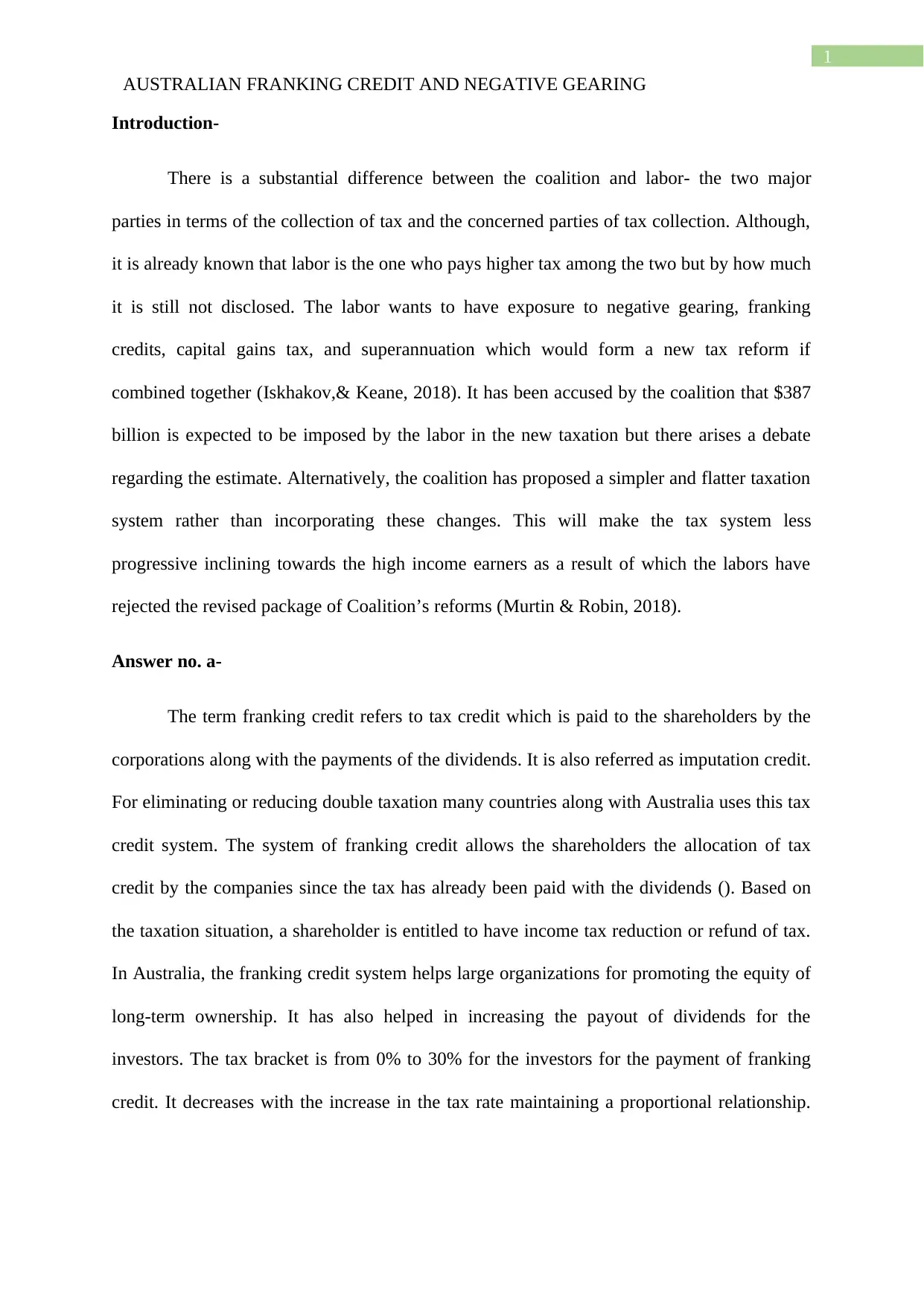
1
AUSTRALIAN FRANKING CREDIT AND NEGATIVE GEARING
Introduction-
There is a substantial difference between the coalition and labor- the two major
parties in terms of the collection of tax and the concerned parties of tax collection. Although,
it is already known that labor is the one who pays higher tax among the two but by how much
it is still not disclosed. The labor wants to have exposure to negative gearing, franking
credits, capital gains tax, and superannuation which would form a new tax reform if
combined together (Iskhakov,& Keane, 2018). It has been accused by the coalition that $387
billion is expected to be imposed by the labor in the new taxation but there arises a debate
regarding the estimate. Alternatively, the coalition has proposed a simpler and flatter taxation
system rather than incorporating these changes. This will make the tax system less
progressive inclining towards the high income earners as a result of which the labors have
rejected the revised package of Coalition’s reforms (Murtin & Robin, 2018).
Answer no. a-
The term franking credit refers to tax credit which is paid to the shareholders by the
corporations along with the payments of the dividends. It is also referred as imputation credit.
For eliminating or reducing double taxation many countries along with Australia uses this tax
credit system. The system of franking credit allows the shareholders the allocation of tax
credit by the companies since the tax has already been paid with the dividends (). Based on
the taxation situation, a shareholder is entitled to have income tax reduction or refund of tax.
In Australia, the franking credit system helps large organizations for promoting the equity of
long-term ownership. It has also helped in increasing the payout of dividends for the
investors. The tax bracket is from 0% to 30% for the investors for the payment of franking
credit. It decreases with the increase in the tax rate maintaining a proportional relationship.
AUSTRALIAN FRANKING CREDIT AND NEGATIVE GEARING
Introduction-
There is a substantial difference between the coalition and labor- the two major
parties in terms of the collection of tax and the concerned parties of tax collection. Although,
it is already known that labor is the one who pays higher tax among the two but by how much
it is still not disclosed. The labor wants to have exposure to negative gearing, franking
credits, capital gains tax, and superannuation which would form a new tax reform if
combined together (Iskhakov,& Keane, 2018). It has been accused by the coalition that $387
billion is expected to be imposed by the labor in the new taxation but there arises a debate
regarding the estimate. Alternatively, the coalition has proposed a simpler and flatter taxation
system rather than incorporating these changes. This will make the tax system less
progressive inclining towards the high income earners as a result of which the labors have
rejected the revised package of Coalition’s reforms (Murtin & Robin, 2018).
Answer no. a-
The term franking credit refers to tax credit which is paid to the shareholders by the
corporations along with the payments of the dividends. It is also referred as imputation credit.
For eliminating or reducing double taxation many countries along with Australia uses this tax
credit system. The system of franking credit allows the shareholders the allocation of tax
credit by the companies since the tax has already been paid with the dividends (). Based on
the taxation situation, a shareholder is entitled to have income tax reduction or refund of tax.
In Australia, the franking credit system helps large organizations for promoting the equity of
long-term ownership. It has also helped in increasing the payout of dividends for the
investors. The tax bracket is from 0% to 30% for the investors for the payment of franking
credit. It decreases with the increase in the tax rate maintaining a proportional relationship.
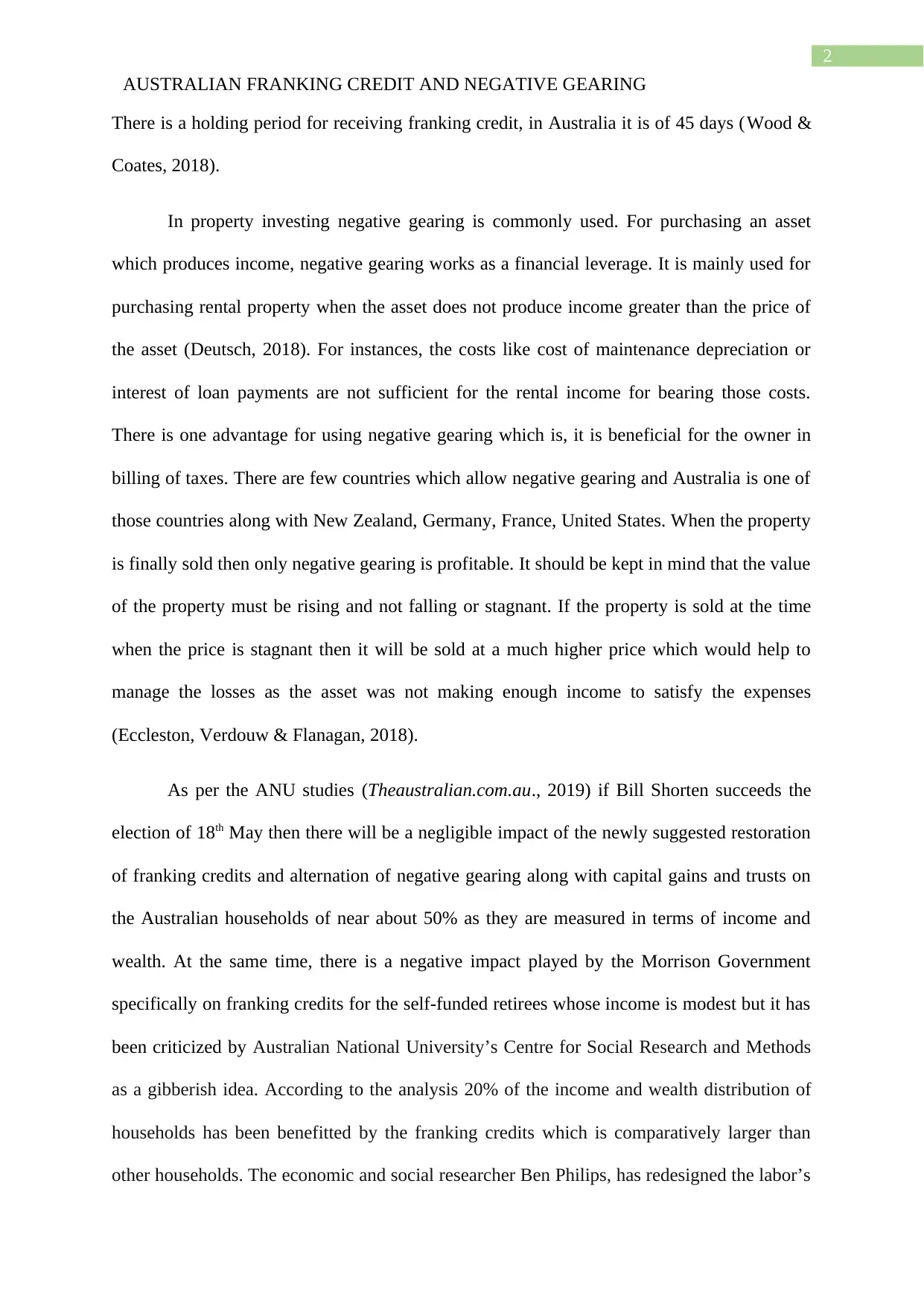
2
AUSTRALIAN FRANKING CREDIT AND NEGATIVE GEARING
There is a holding period for receiving franking credit, in Australia it is of 45 days (Wood &
Coates, 2018).
In property investing negative gearing is commonly used. For purchasing an asset
which produces income, negative gearing works as a financial leverage. It is mainly used for
purchasing rental property when the asset does not produce income greater than the price of
the asset (Deutsch, 2018). For instances, the costs like cost of maintenance depreciation or
interest of loan payments are not sufficient for the rental income for bearing those costs.
There is one advantage for using negative gearing which is, it is beneficial for the owner in
billing of taxes. There are few countries which allow negative gearing and Australia is one of
those countries along with New Zealand, Germany, France, United States. When the property
is finally sold then only negative gearing is profitable. It should be kept in mind that the value
of the property must be rising and not falling or stagnant. If the property is sold at the time
when the price is stagnant then it will be sold at a much higher price which would help to
manage the losses as the asset was not making enough income to satisfy the expenses
(Eccleston, Verdouw & Flanagan, 2018).
As per the ANU studies (Theaustralian.com.au., 2019) if Bill Shorten succeeds the
election of 18th May then there will be a negligible impact of the newly suggested restoration
of franking credits and alternation of negative gearing along with capital gains and trusts on
the Australian households of near about 50% as they are measured in terms of income and
wealth. At the same time, there is a negative impact played by the Morrison Government
specifically on franking credits for the self-funded retirees whose income is modest but it has
been criticized by Australian National University’s Centre for Social Research and Methods
as a gibberish idea. According to the analysis 20% of the income and wealth distribution of
households has been benefitted by the franking credits which is comparatively larger than
other households. The economic and social researcher Ben Philips, has redesigned the labor’s
AUSTRALIAN FRANKING CREDIT AND NEGATIVE GEARING
There is a holding period for receiving franking credit, in Australia it is of 45 days (Wood &
Coates, 2018).
In property investing negative gearing is commonly used. For purchasing an asset
which produces income, negative gearing works as a financial leverage. It is mainly used for
purchasing rental property when the asset does not produce income greater than the price of
the asset (Deutsch, 2018). For instances, the costs like cost of maintenance depreciation or
interest of loan payments are not sufficient for the rental income for bearing those costs.
There is one advantage for using negative gearing which is, it is beneficial for the owner in
billing of taxes. There are few countries which allow negative gearing and Australia is one of
those countries along with New Zealand, Germany, France, United States. When the property
is finally sold then only negative gearing is profitable. It should be kept in mind that the value
of the property must be rising and not falling or stagnant. If the property is sold at the time
when the price is stagnant then it will be sold at a much higher price which would help to
manage the losses as the asset was not making enough income to satisfy the expenses
(Eccleston, Verdouw & Flanagan, 2018).
As per the ANU studies (Theaustralian.com.au., 2019) if Bill Shorten succeeds the
election of 18th May then there will be a negligible impact of the newly suggested restoration
of franking credits and alternation of negative gearing along with capital gains and trusts on
the Australian households of near about 50% as they are measured in terms of income and
wealth. At the same time, there is a negative impact played by the Morrison Government
specifically on franking credits for the self-funded retirees whose income is modest but it has
been criticized by Australian National University’s Centre for Social Research and Methods
as a gibberish idea. According to the analysis 20% of the income and wealth distribution of
households has been benefitted by the franking credits which is comparatively larger than
other households. The economic and social researcher Ben Philips, has redesigned the labor’s
⊘ This is a preview!⊘
Do you want full access?
Subscribe today to unlock all pages.

Trusted by 1+ million students worldwide
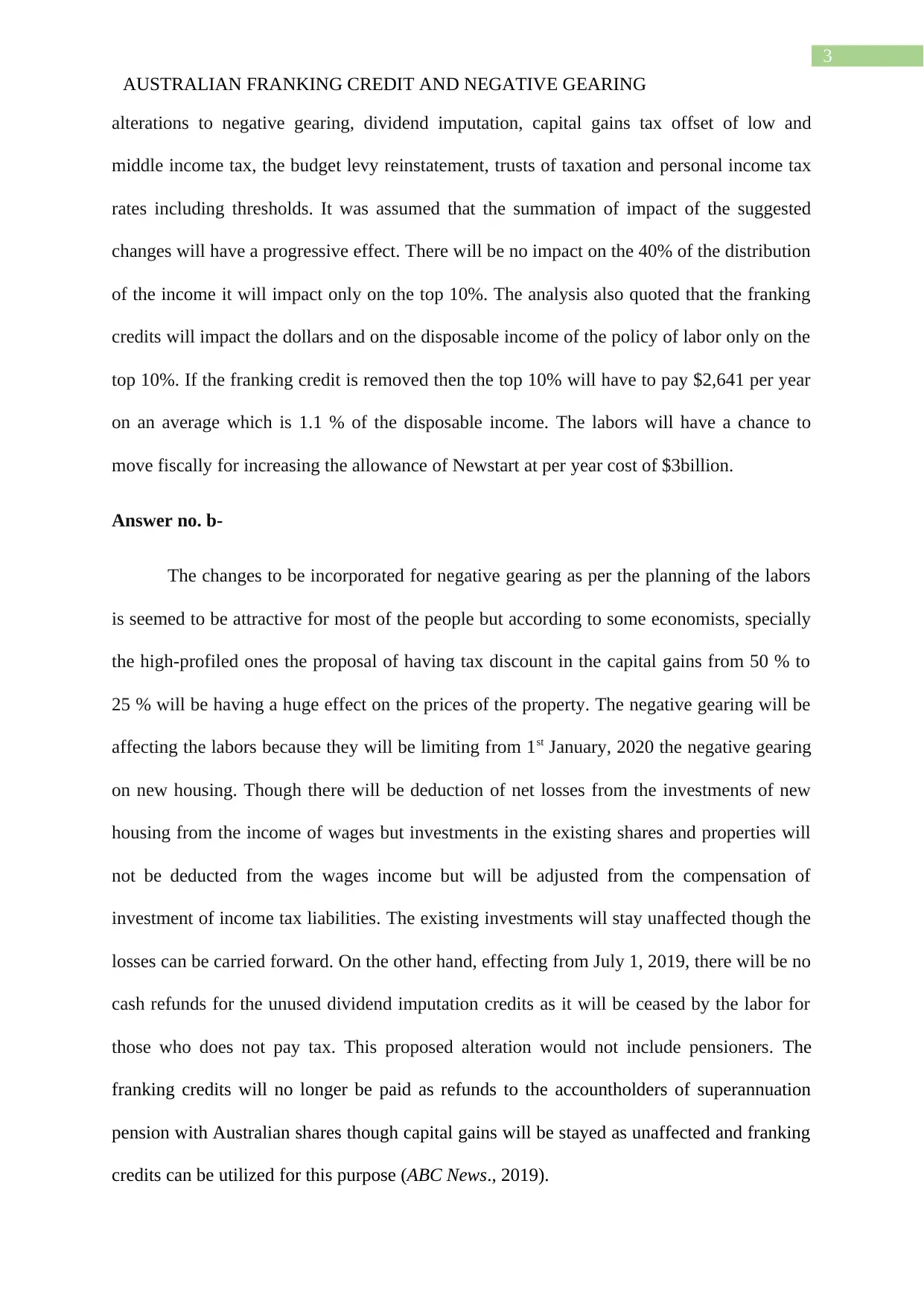
3
AUSTRALIAN FRANKING CREDIT AND NEGATIVE GEARING
alterations to negative gearing, dividend imputation, capital gains tax offset of low and
middle income tax, the budget levy reinstatement, trusts of taxation and personal income tax
rates including thresholds. It was assumed that the summation of impact of the suggested
changes will have a progressive effect. There will be no impact on the 40% of the distribution
of the income it will impact only on the top 10%. The analysis also quoted that the franking
credits will impact the dollars and on the disposable income of the policy of labor only on the
top 10%. If the franking credit is removed then the top 10% will have to pay $2,641 per year
on an average which is 1.1 % of the disposable income. The labors will have a chance to
move fiscally for increasing the allowance of Newstart at per year cost of $3billion.
Answer no. b-
The changes to be incorporated for negative gearing as per the planning of the labors
is seemed to be attractive for most of the people but according to some economists, specially
the high-profiled ones the proposal of having tax discount in the capital gains from 50 % to
25 % will be having a huge effect on the prices of the property. The negative gearing will be
affecting the labors because they will be limiting from 1st January, 2020 the negative gearing
on new housing. Though there will be deduction of net losses from the investments of new
housing from the income of wages but investments in the existing shares and properties will
not be deducted from the wages income but will be adjusted from the compensation of
investment of income tax liabilities. The existing investments will stay unaffected though the
losses can be carried forward. On the other hand, effecting from July 1, 2019, there will be no
cash refunds for the unused dividend imputation credits as it will be ceased by the labor for
those who does not pay tax. This proposed alteration would not include pensioners. The
franking credits will no longer be paid as refunds to the accountholders of superannuation
pension with Australian shares though capital gains will be stayed as unaffected and franking
credits can be utilized for this purpose (ABC News., 2019).
AUSTRALIAN FRANKING CREDIT AND NEGATIVE GEARING
alterations to negative gearing, dividend imputation, capital gains tax offset of low and
middle income tax, the budget levy reinstatement, trusts of taxation and personal income tax
rates including thresholds. It was assumed that the summation of impact of the suggested
changes will have a progressive effect. There will be no impact on the 40% of the distribution
of the income it will impact only on the top 10%. The analysis also quoted that the franking
credits will impact the dollars and on the disposable income of the policy of labor only on the
top 10%. If the franking credit is removed then the top 10% will have to pay $2,641 per year
on an average which is 1.1 % of the disposable income. The labors will have a chance to
move fiscally for increasing the allowance of Newstart at per year cost of $3billion.
Answer no. b-
The changes to be incorporated for negative gearing as per the planning of the labors
is seemed to be attractive for most of the people but according to some economists, specially
the high-profiled ones the proposal of having tax discount in the capital gains from 50 % to
25 % will be having a huge effect on the prices of the property. The negative gearing will be
affecting the labors because they will be limiting from 1st January, 2020 the negative gearing
on new housing. Though there will be deduction of net losses from the investments of new
housing from the income of wages but investments in the existing shares and properties will
not be deducted from the wages income but will be adjusted from the compensation of
investment of income tax liabilities. The existing investments will stay unaffected though the
losses can be carried forward. On the other hand, effecting from July 1, 2019, there will be no
cash refunds for the unused dividend imputation credits as it will be ceased by the labor for
those who does not pay tax. This proposed alteration would not include pensioners. The
franking credits will no longer be paid as refunds to the accountholders of superannuation
pension with Australian shares though capital gains will be stayed as unaffected and franking
credits can be utilized for this purpose (ABC News., 2019).
Paraphrase This Document
Need a fresh take? Get an instant paraphrase of this document with our AI Paraphraser
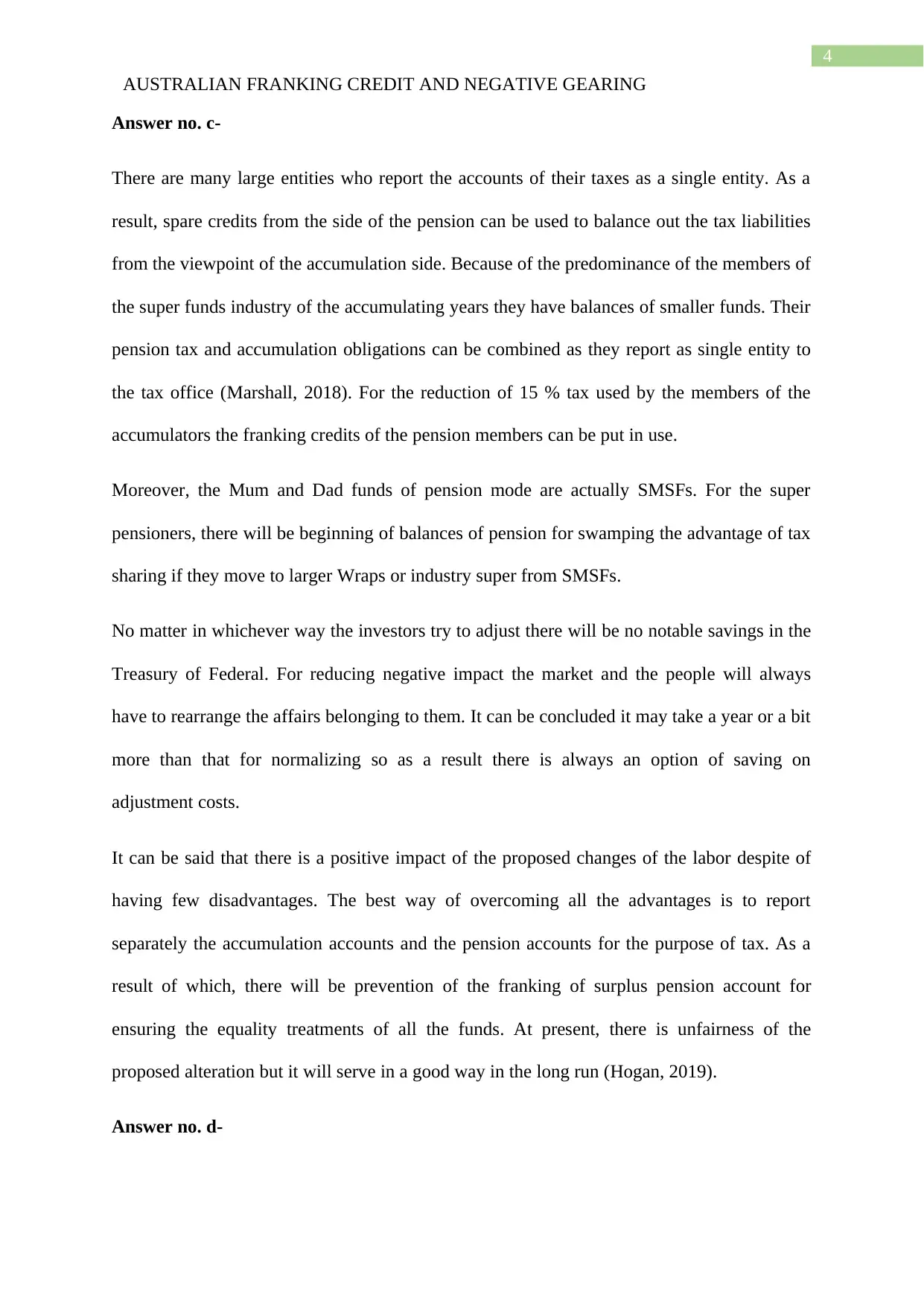
4
AUSTRALIAN FRANKING CREDIT AND NEGATIVE GEARING
Answer no. c-
There are many large entities who report the accounts of their taxes as a single entity. As a
result, spare credits from the side of the pension can be used to balance out the tax liabilities
from the viewpoint of the accumulation side. Because of the predominance of the members of
the super funds industry of the accumulating years they have balances of smaller funds. Their
pension tax and accumulation obligations can be combined as they report as single entity to
the tax office (Marshall, 2018). For the reduction of 15 % tax used by the members of the
accumulators the franking credits of the pension members can be put in use.
Moreover, the Mum and Dad funds of pension mode are actually SMSFs. For the super
pensioners, there will be beginning of balances of pension for swamping the advantage of tax
sharing if they move to larger Wraps or industry super from SMSFs.
No matter in whichever way the investors try to adjust there will be no notable savings in the
Treasury of Federal. For reducing negative impact the market and the people will always
have to rearrange the affairs belonging to them. It can be concluded it may take a year or a bit
more than that for normalizing so as a result there is always an option of saving on
adjustment costs.
It can be said that there is a positive impact of the proposed changes of the labor despite of
having few disadvantages. The best way of overcoming all the advantages is to report
separately the accumulation accounts and the pension accounts for the purpose of tax. As a
result of which, there will be prevention of the franking of surplus pension account for
ensuring the equality treatments of all the funds. At present, there is unfairness of the
proposed alteration but it will serve in a good way in the long run (Hogan, 2019).
Answer no. d-
AUSTRALIAN FRANKING CREDIT AND NEGATIVE GEARING
Answer no. c-
There are many large entities who report the accounts of their taxes as a single entity. As a
result, spare credits from the side of the pension can be used to balance out the tax liabilities
from the viewpoint of the accumulation side. Because of the predominance of the members of
the super funds industry of the accumulating years they have balances of smaller funds. Their
pension tax and accumulation obligations can be combined as they report as single entity to
the tax office (Marshall, 2018). For the reduction of 15 % tax used by the members of the
accumulators the franking credits of the pension members can be put in use.
Moreover, the Mum and Dad funds of pension mode are actually SMSFs. For the super
pensioners, there will be beginning of balances of pension for swamping the advantage of tax
sharing if they move to larger Wraps or industry super from SMSFs.
No matter in whichever way the investors try to adjust there will be no notable savings in the
Treasury of Federal. For reducing negative impact the market and the people will always
have to rearrange the affairs belonging to them. It can be concluded it may take a year or a bit
more than that for normalizing so as a result there is always an option of saving on
adjustment costs.
It can be said that there is a positive impact of the proposed changes of the labor despite of
having few disadvantages. The best way of overcoming all the advantages is to report
separately the accumulation accounts and the pension accounts for the purpose of tax. As a
result of which, there will be prevention of the franking of surplus pension account for
ensuring the equality treatments of all the funds. At present, there is unfairness of the
proposed alteration but it will serve in a good way in the long run (Hogan, 2019).
Answer no. d-
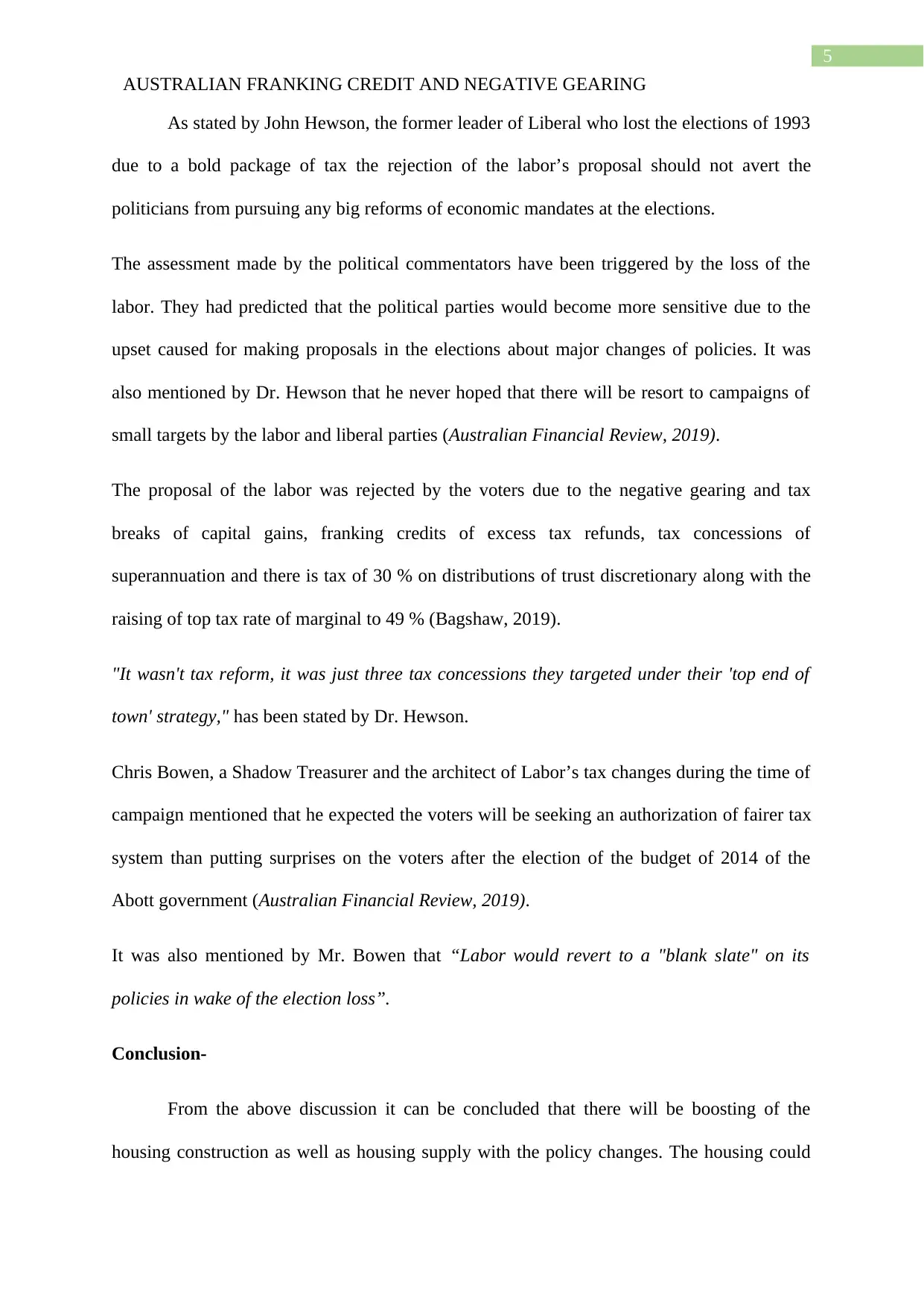
5
AUSTRALIAN FRANKING CREDIT AND NEGATIVE GEARING
As stated by John Hewson, the former leader of Liberal who lost the elections of 1993
due to a bold package of tax the rejection of the labor’s proposal should not avert the
politicians from pursuing any big reforms of economic mandates at the elections.
The assessment made by the political commentators have been triggered by the loss of the
labor. They had predicted that the political parties would become more sensitive due to the
upset caused for making proposals in the elections about major changes of policies. It was
also mentioned by Dr. Hewson that he never hoped that there will be resort to campaigns of
small targets by the labor and liberal parties (Australian Financial Review, 2019).
The proposal of the labor was rejected by the voters due to the negative gearing and tax
breaks of capital gains, franking credits of excess tax refunds, tax concessions of
superannuation and there is tax of 30 % on distributions of trust discretionary along with the
raising of top tax rate of marginal to 49 % (Bagshaw, 2019).
"It wasn't tax reform, it was just three tax concessions they targeted under their 'top end of
town' strategy," has been stated by Dr. Hewson.
Chris Bowen, a Shadow Treasurer and the architect of Labor’s tax changes during the time of
campaign mentioned that he expected the voters will be seeking an authorization of fairer tax
system than putting surprises on the voters after the election of the budget of 2014 of the
Abott government (Australian Financial Review, 2019).
It was also mentioned by Mr. Bowen that “Labor would revert to a "blank slate" on its
policies in wake of the election loss”.
Conclusion-
From the above discussion it can be concluded that there will be boosting of the
housing construction as well as housing supply with the policy changes. The housing could
AUSTRALIAN FRANKING CREDIT AND NEGATIVE GEARING
As stated by John Hewson, the former leader of Liberal who lost the elections of 1993
due to a bold package of tax the rejection of the labor’s proposal should not avert the
politicians from pursuing any big reforms of economic mandates at the elections.
The assessment made by the political commentators have been triggered by the loss of the
labor. They had predicted that the political parties would become more sensitive due to the
upset caused for making proposals in the elections about major changes of policies. It was
also mentioned by Dr. Hewson that he never hoped that there will be resort to campaigns of
small targets by the labor and liberal parties (Australian Financial Review, 2019).
The proposal of the labor was rejected by the voters due to the negative gearing and tax
breaks of capital gains, franking credits of excess tax refunds, tax concessions of
superannuation and there is tax of 30 % on distributions of trust discretionary along with the
raising of top tax rate of marginal to 49 % (Bagshaw, 2019).
"It wasn't tax reform, it was just three tax concessions they targeted under their 'top end of
town' strategy," has been stated by Dr. Hewson.
Chris Bowen, a Shadow Treasurer and the architect of Labor’s tax changes during the time of
campaign mentioned that he expected the voters will be seeking an authorization of fairer tax
system than putting surprises on the voters after the election of the budget of 2014 of the
Abott government (Australian Financial Review, 2019).
It was also mentioned by Mr. Bowen that “Labor would revert to a "blank slate" on its
policies in wake of the election loss”.
Conclusion-
From the above discussion it can be concluded that there will be boosting of the
housing construction as well as housing supply with the policy changes. The housing could
⊘ This is a preview!⊘
Do you want full access?
Subscribe today to unlock all pages.

Trusted by 1+ million students worldwide

6
AUSTRALIAN FRANKING CREDIT AND NEGATIVE GEARING
become more affordable as a result of this policy change as the aggregate Australian housing
prices would fall. As a result of this change in policy, there would have been ceasing of
increase in policy. It can also be mentioned that there would not be any negative impact on
the economy due to this policy change. Referring the market conditions, this would have been
a favorable time for introducing policy change in the markets.
AUSTRALIAN FRANKING CREDIT AND NEGATIVE GEARING
become more affordable as a result of this policy change as the aggregate Australian housing
prices would fall. As a result of this change in policy, there would have been ceasing of
increase in policy. It can also be mentioned that there would not be any negative impact on
the economy due to this policy change. Referring the market conditions, this would have been
a favorable time for introducing policy change in the markets.
Paraphrase This Document
Need a fresh take? Get an instant paraphrase of this document with our AI Paraphraser
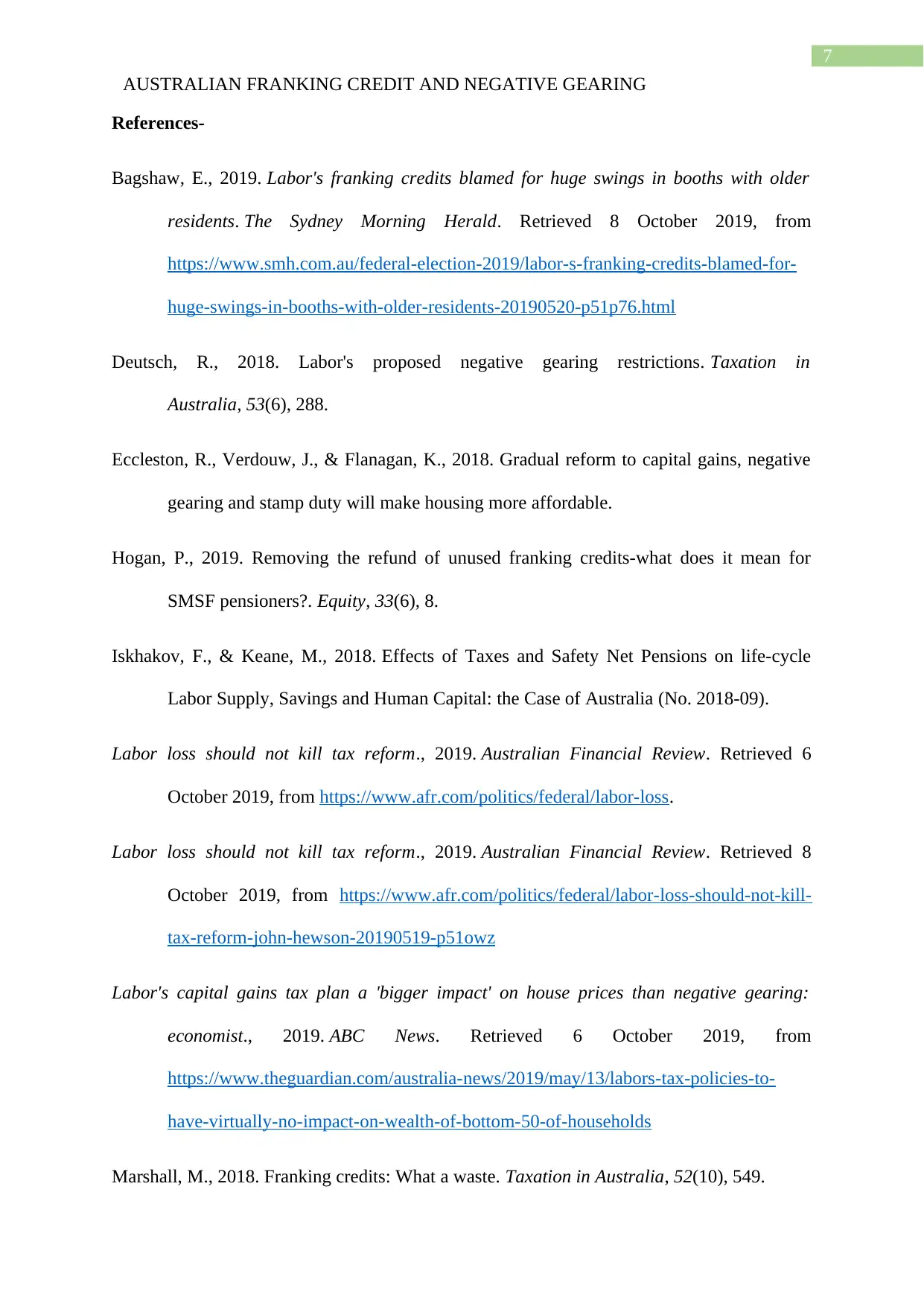
7
AUSTRALIAN FRANKING CREDIT AND NEGATIVE GEARING
References-
Bagshaw, E., 2019. Labor's franking credits blamed for huge swings in booths with older
residents. The Sydney Morning Herald. Retrieved 8 October 2019, from
https://www.smh.com.au/federal-election-2019/labor-s-franking-credits-blamed-for-
huge-swings-in-booths-with-older-residents-20190520-p51p76.html
Deutsch, R., 2018. Labor's proposed negative gearing restrictions. Taxation in
Australia, 53(6), 288.
Eccleston, R., Verdouw, J., & Flanagan, K., 2018. Gradual reform to capital gains, negative
gearing and stamp duty will make housing more affordable.
Hogan, P., 2019. Removing the refund of unused franking credits-what does it mean for
SMSF pensioners?. Equity, 33(6), 8.
Iskhakov, F., & Keane, M., 2018. Effects of Taxes and Safety Net Pensions on life-cycle
Labor Supply, Savings and Human Capital: the Case of Australia (No. 2018-09).
Labor loss should not kill tax reform., 2019. Australian Financial Review. Retrieved 6
October 2019, from https://www.afr.com/politics/federal/labor-loss.
Labor loss should not kill tax reform., 2019. Australian Financial Review. Retrieved 8
October 2019, from https://www.afr.com/politics/federal/labor-loss-should-not-kill-
tax-reform-john-hewson-20190519-p51owz
Labor's capital gains tax plan a 'bigger impact' on house prices than negative gearing:
economist., 2019. ABC News. Retrieved 6 October 2019, from
https://www.theguardian.com/australia-news/2019/may/13/labors-tax-policies-to-
have-virtually-no-impact-on-wealth-of-bottom-50-of-households
Marshall, M., 2018. Franking credits: What a waste. Taxation in Australia, 52(10), 549.
AUSTRALIAN FRANKING CREDIT AND NEGATIVE GEARING
References-
Bagshaw, E., 2019. Labor's franking credits blamed for huge swings in booths with older
residents. The Sydney Morning Herald. Retrieved 8 October 2019, from
https://www.smh.com.au/federal-election-2019/labor-s-franking-credits-blamed-for-
huge-swings-in-booths-with-older-residents-20190520-p51p76.html
Deutsch, R., 2018. Labor's proposed negative gearing restrictions. Taxation in
Australia, 53(6), 288.
Eccleston, R., Verdouw, J., & Flanagan, K., 2018. Gradual reform to capital gains, negative
gearing and stamp duty will make housing more affordable.
Hogan, P., 2019. Removing the refund of unused franking credits-what does it mean for
SMSF pensioners?. Equity, 33(6), 8.
Iskhakov, F., & Keane, M., 2018. Effects of Taxes and Safety Net Pensions on life-cycle
Labor Supply, Savings and Human Capital: the Case of Australia (No. 2018-09).
Labor loss should not kill tax reform., 2019. Australian Financial Review. Retrieved 6
October 2019, from https://www.afr.com/politics/federal/labor-loss.
Labor loss should not kill tax reform., 2019. Australian Financial Review. Retrieved 8
October 2019, from https://www.afr.com/politics/federal/labor-loss-should-not-kill-
tax-reform-john-hewson-20190519-p51owz
Labor's capital gains tax plan a 'bigger impact' on house prices than negative gearing:
economist., 2019. ABC News. Retrieved 6 October 2019, from
https://www.theguardian.com/australia-news/2019/may/13/labors-tax-policies-to-
have-virtually-no-impact-on-wealth-of-bottom-50-of-households
Marshall, M., 2018. Franking credits: What a waste. Taxation in Australia, 52(10), 549.
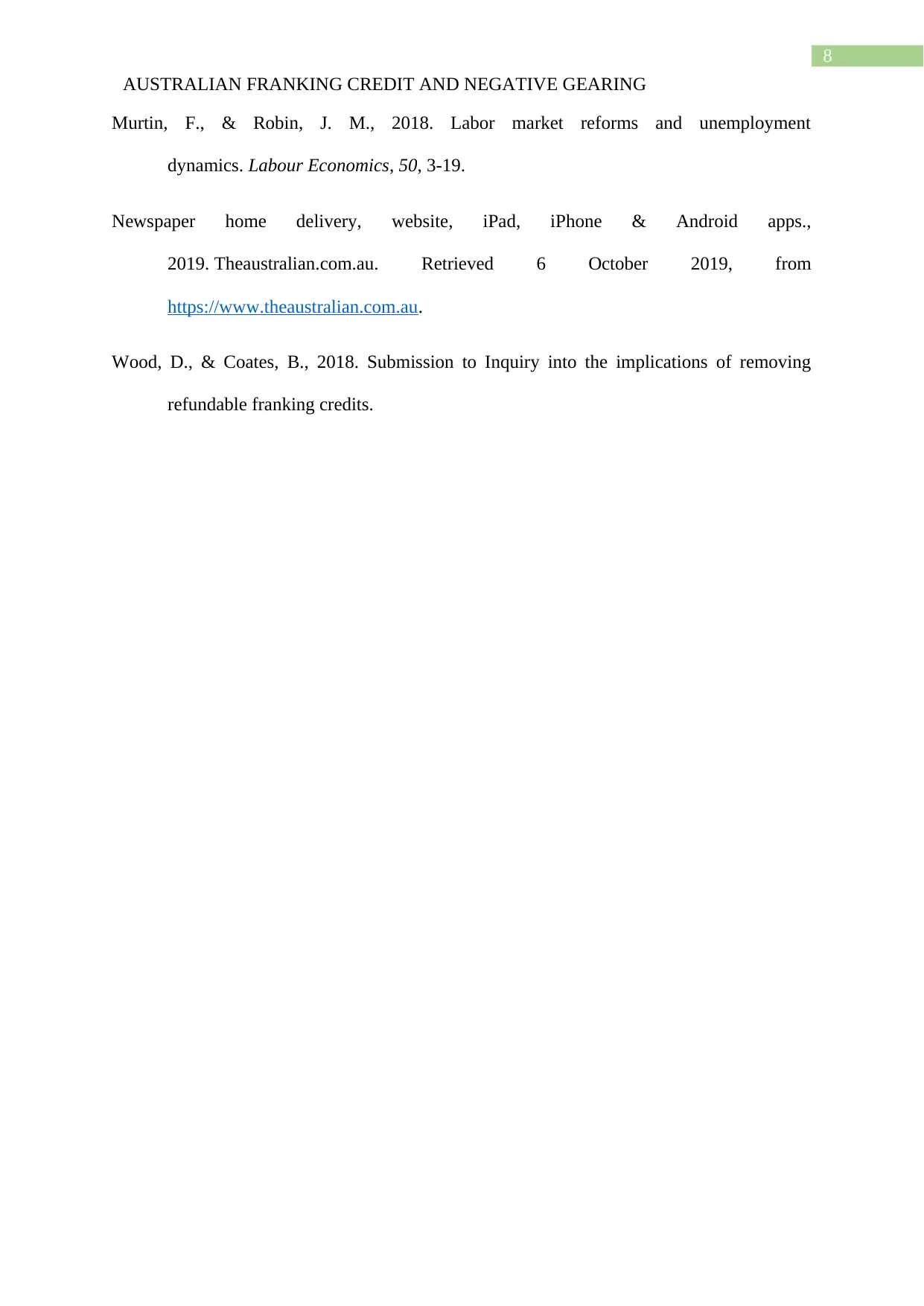
8
AUSTRALIAN FRANKING CREDIT AND NEGATIVE GEARING
Murtin, F., & Robin, J. M., 2018. Labor market reforms and unemployment
dynamics. Labour Economics, 50, 3-19.
Newspaper home delivery, website, iPad, iPhone & Android apps.,
2019. Theaustralian.com.au. Retrieved 6 October 2019, from
https://www.theaustralian.com.au.
Wood, D., & Coates, B., 2018. Submission to Inquiry into the implications of removing
refundable franking credits.
AUSTRALIAN FRANKING CREDIT AND NEGATIVE GEARING
Murtin, F., & Robin, J. M., 2018. Labor market reforms and unemployment
dynamics. Labour Economics, 50, 3-19.
Newspaper home delivery, website, iPad, iPhone & Android apps.,
2019. Theaustralian.com.au. Retrieved 6 October 2019, from
https://www.theaustralian.com.au.
Wood, D., & Coates, B., 2018. Submission to Inquiry into the implications of removing
refundable franking credits.
⊘ This is a preview!⊘
Do you want full access?
Subscribe today to unlock all pages.

Trusted by 1+ million students worldwide
1 out of 9
Related Documents
Your All-in-One AI-Powered Toolkit for Academic Success.
+13062052269
info@desklib.com
Available 24*7 on WhatsApp / Email
![[object Object]](/_next/static/media/star-bottom.7253800d.svg)
Unlock your academic potential
Copyright © 2020–2025 A2Z Services. All Rights Reserved. Developed and managed by ZUCOL.





